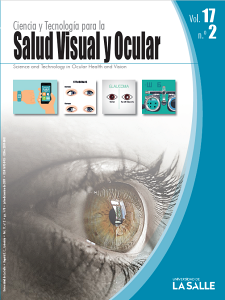##article.abstract##
<strong>Background:</strong> While a number of previous studies have investigated the repeatability of techniques designed to measure heterophoria, there have been few studies of their validity. Accordingly, the present study examined the ability of 3 standard techniques; Von Graefe (VG), Maddox Rod (MR) and Modified Thorington (MT) tests to quantify a known change in heterophoria. <strong>Methods:</strong>The study was performed on 30 young subjects using each of the 3 procedures listed above. Near (40 cm) heterophoria was quantified both without and with an additional base-out prism. Five possible values were available, namely 2, 4, 6, 8 and 9Δ. After a period of 24 hours, the heterophoria measurement was repeated using the same technique with one of these prisms added to the refractive correction. <strong>Results:</strong>The mean heterophoria value measured before the introduction of prism using the VG procedure was significantly more exophoric than the findings obtained using the other 2 techniques (p = 0.035). No significant difference was observed between the measured and predicted change in heterophoria following the introduction of the prism for the VG and MT procedures, but a significant difference was found with the MR technique (p<0.001). <strong>Conclusions:</strong>The ability to measure a known change in oculomotor deviation was significantly poorer with the MR technique, when compared with the VG and MT procedures. Given that the mean pre-prism measurement was significantly more exophoric when using the VG procedure, we recommend that MT be adopted as the technique of choice for the subjective measurement of oculomotor deviations in the clinical setting##submission.citations##
Steinman SB, Steinman BA. Foundations of Binocular Vision. A clinical perspective. 1st ed. McGraw-Hill: New York; 2000. p. 57
Wajuihian SO. Prevalence of heterophoria and its association with near fusional vergence ranges and refractive errors. African Vis Eye Health. 2018;77(1):1-9
Grosvenor T. Primary care optometry. 4th ed. Philadelphia, PA: Butterworth Heinemann Elsevier; 2002. p. 101
Yekta A, Moghaddam SG, Khabazkhoob M. Prevalence and risk factors of near decompensated heterophoria in a population of university students. Acta Ophthalmol. 2011;89(supl. 248). https://doi.org/10.1111/j.1755-3768.2011.320.x
Von Noorden GK. Binocular Vision and Ocular Motility. 5th ed. St. Louis, MO: Mosby; 1995. p. 150
Escalante JB, Rosenfield M. Effect of heterophoria measurement technique on the clinical accommodative convergence to accommodation ratio. Optometry. 2006;77(5):229-34
Cebrián JL, Antona B, Barrio A, González E, Gutiérrez A, Sánchez I. Repeatability of the Modified Thorington Card used to measure far heterophoria. Optom Vis Sci. 2014;91:786-792
Goss DA, Moyer B, Teske MC. Comparison of dissociated phoria test findings with Von Graefe phorometry and Modified Thorington testing. J Behav Optom. 2008;(6):145-9
Rosenfield M. Tonic vergence and vergence adaptation. Optom Vis Sci. 1997;74(5):303-28
Rosenfield M, Chun TW, Fischer SE. Effect of prolonged dissociation on the subjective measurement of near heterophoria. Ophthal Physiol Opt. 1997;17(6):478-82
Rainey BB, Schroeder TL, Goss DA, Grosvenor T. Inter-examiner repeatability of heterophoria tests. Optom Vis Sci. 1998;75(10):719-26
Casillas EC, Rosenfield M. Comparison of subjective heterophoria testing with a phoropter and trial frame. Optom Vis Sci. 2006;83(4):237-41
Ciuffreda KJ, Levi DM, Selenow A. Amblyopia: basic and clinical aspects. Boston: Butterworth-Heinemann; 1991
Campos EC, Catellani T. Further evidence For the fusional nature of the compensation (or "eating up") prisms in concomitant strabismus. Int Ophthalmol. 1978;1(1):57-62
